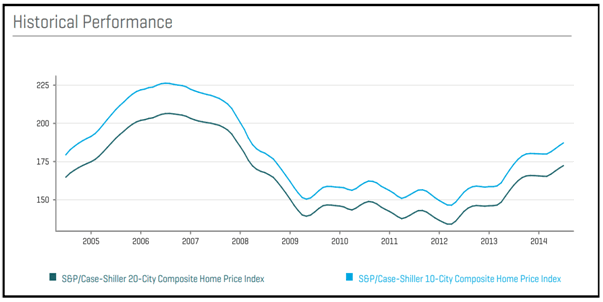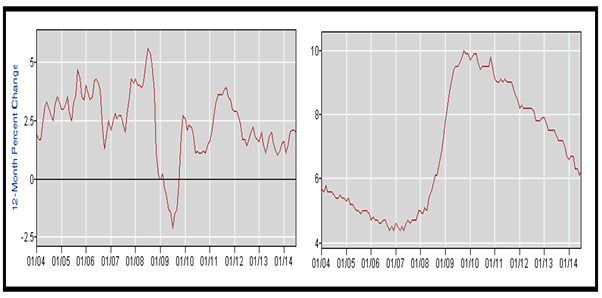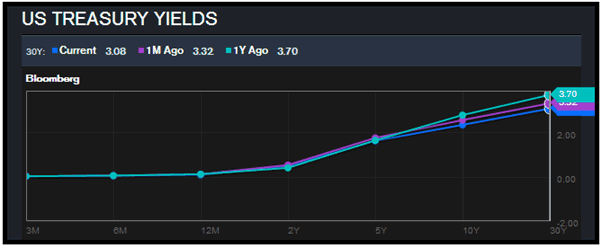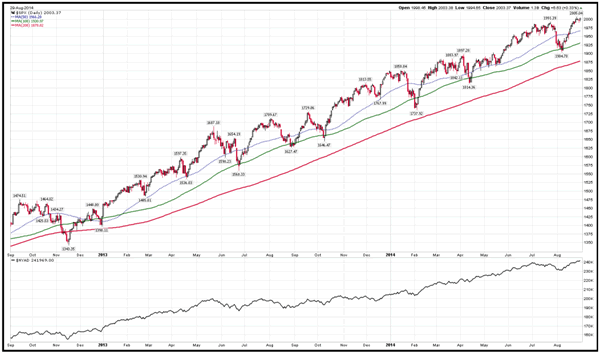Better Days Ahead For U.S. Stock And Housing Market
Stock-Markets / Financial Markets 2014 Sep 12, 2014 - 10:01 AM GMTBy: Puru_Saxena
 BIG PICTURE – After bottoming out in 2012, America’s housing market has climbed to a 6-year high and it is probable that the 2006-record will be surpassed within the next 2-3 years.
BIG PICTURE – After bottoming out in 2012, America’s housing market has climbed to a 6-year high and it is probable that the 2006-record will be surpassed within the next 2-3 years.
You will recall that we first turned positive about America’s housing market two years ago and at that time, we forecasted a multi-year upswing. Fast forward to today and property prices have already risen over the past couple of years and we expect them to appreciate for at least another 2-3 years.
Look. America’s housing market is highly cyclical in nature and historically, upswings have lasted for several years. Accordingly, it is conceivable that the ongoing bull market will also continue for longer than most investors anticipate at this time.
If you review Figure 1, you will observe that after a lengthy consolidation phase, the S&P/Case-Schiller Home Price Indices have climbed to levels not seen since 2008. This is in line with our expectation and we believe that the 2006-record will be taken out during this multi-year upswing.
Figure 1: US housing – bull market underway!

Source: S&P Dow Jones Indices
Although the 2006-2009 housing bust was brutal, enough time has now elapsed to sustain a multi-year bull market in real-estate. Furthermore, household formation and inflation are two factors which will continue to support property prices over the long-term.
Since the housing industry in the US employs millions of people, the ongoing recovery in real-estate will prove extremely beneficial for the world’s largest economy. It is notable that over the past several months, construction jobs have accounted for approximately 15% of employment growth in the US and this trend will probably accelerate in the future.
As millions of Americans return to full-time employment, they will start spending on discretionary items, thereby unleashing pent-up demand. Moreover, as home prices continue to rise, the ‘wealth effect’ will have a tremendous impact on consumer sentiment and this will bring about prosperity in the US.
Make no mistake, the ongoing bull market in housing has been engineered by the Federal Reserve and the eventual monetary tightening will bring about the next bust. At present, the Fed Funds Rate is still at a historic low and most market participants are keenly monitoring data points to see when Ms. Yellen will start raising short-term rates.
If you review Figure 2, you will note that the US CPI rose by 2% over the past 12-months (left panel) and the US unemployment rate has now declined to approximately 6% (right panel). Given the fact that the rate of inflation is now hitting against the Federal Reserve’s target rate and the jobs market is significantly better, the first interest rate hike must not be too far away.
Figure 2: US economic data (CPI and Unemployment rate)

Source: Bureau of Labor Statistics
Although nobody really knows when the monetary tightening cycle will commence, we suspect that the first rate hike will occur in 6-9 months. If asset markets continue to advance until spring (likely scenario), then in an attempt to thwart animal spirits, it is likely that Ms. Yellen will raise the Fed Funds Rate in the first or second quarter of next year.
When that happens, the stock market will probably embark on a 10-15% pullback but the initial move by the Federal Reserve should not trigger the next prolonged bear market. After all, previous bull markets in history ended after several months of monetary tightening, so the ongoing primary uptrend should also continue until late into the rate hiking cycle.
Whilst we are on the topic of interest rates, it is worth mentioning that that long dated interest rates in the US have declined dramatically since January. In fact, the decline in the 30-Year US Treasury Yield has been relentless and we are now trading at a multi-month low.
From our perspective, this slide in long dated bond yields has been brought about by the resurgence in deflationary fears. You will recall that when the previous rounds of quantitative easing ended, market participants prepared for a deflationary scare by buying long dated US Treasury securities. This appears to be happening again and (once again) capital is flowing towards the safety of US government bonds.
At this stage, it is difficult to know whether the end of quantitative easing will bring about an economic slowdown. However, if the housing market holds up in the US and business activity remains resilient, bond yields may reverse course and appreciate sharply.
Although long dated interest rates in the US have depreciated over the past year and the yield curve has flattened somewhat, it still remains pretty steep (Figure 3). Undoubtedly, this is good news for the stock market and supportive of our bullish hypothesis.
Figure 3: US yield curve remains steep

Source: Bloomberg
As stated previously, prolonged bear markets in the past have always been preceded by the inversion of the yield curve, so the steep yield curve should sustain the ongoing festivities on Wall Street.
In addition to the favourable monetary environment, the technical data also remains supportive of the stock market. For instance, approximately 70% of the NYSE stocks are currently trading above the 200-day moving average, new 52-week highs are significantly greater than the new 52-week lows and the Volatility Index (VIX) has plunged.
More importantly, the stock market’s breadth is strong and the NYSE Advance/Decline Line has climbed to a record high (Figure 4 - lower panel, on the following page). It is noteworthy that during the previous bull markets, the NYSE Advance/Decline Line always topped out several months before the stock market, so the current strength in this indicator suggests that this uptrend has further to run.
Although there are no imminent red flags, there can be no denying the fact that we are indeed in the mature phase of this bull market. After all, the primary uptrend commenced in March 2009, so this advance is already over 5 years old. Furthermore, as is typical of a mature bull market, we are seeing a lot of divergence between the various industry groups. Put simply, not every sector is participating in the advance and many leading momentum stocks have already broken down badly.
In terms of the favourable sectors, we are seeing strength in asset managers, airlines, auto companies, auto dealers, banks, biotechnology, energy (midstream and oil services), healthcare, insurance, railroads, real estate brokers, travel and semiconductors. Accordingly, we have allocated our equity portfolio to these areas and this strategy is now well positioned to profit over the following months.
In terms of the weak segments of the market, we are seeing ongoing weakness in the commodities counters, consumer staples, restaurant and retail stocks. Therefore, unless the trend reverses, we do not recommend exposure to these industry groups.
As far as geographical exposure goes, we continue to recommend over-weight positions in the developed world (Europe, Japan and the US). Since April 2011, the developed world has outperformed the emerging nations by a wide margin and we expect this trend to continue for the foreseeable future. However, over the past few weeks, a number of emerging markets ETFs have broken out of multi-month trading ranges, so we now recommend modest exposure this area.
Figure 4: NYSE Advance/Decline Line – new high!

Source: www.stockcharts.com
In terms of specifics, we continue to see incredible momentum in India’s stock market! You will recall that we first recommended exposure to this market several months ago and despite the recent run up, we see plenty of potential.
Elsewhere in Asia, Hong Kong has recently broken out of a lengthy consolidation phase and even Taiwan’s stock market is gaining momentum. So, our readers can consider looking for opportunities in these stock markets.
Over in South America, Brazil’s stock market is showing signs of strength and the uptrend could continue for several months.
In summary, the monetary backdrop remains favourable towards stocks, America’s housing market is rebounding and a variety of technical indicators are showing strength. Therefore, we continue to believe that the ongoing primary uptrend will continue for several months, so our readers should stay fully invested in common stocks.
Although this bull market is mature and we will get some volatility heading into spring, the path of least resistance remains up and investors should stay positioned for the northbound journey.
Puru Saxena publishes Money Matters, a monthly economic report, which highlights extraordinary investment opportunities in all major markets. In addition to the monthly report, subscribers also receive “Weekly Updates” covering the recent market action. Money Matters is available by subscription from www.purusaxena.com.
Puru Saxena
Website – www.purusaxena.com
Puru Saxena is the founder of Puru Saxena Wealth Management, his Hong Kong based firm which manages investment portfolios for individuals and corporate clients. He is a highly showcased investment manager and a regular guest on CNN, BBC World, CNBC, Bloomberg, NDTV and various radio programs.
Copyright © 2005-2014 Puru Saxena Limited. All rights reserved.
Disclaimer: The above is a matter of opinion provided for general information purposes only and is not intended as investment advice. Information and analysis above are derived from sources and utilising methods believed to be reliable, but we cannot accept responsibility for any losses you may incur as a result of this analysis. Individuals should consult with their personal financial advisors.© 2005-2022 http://www.MarketOracle.co.uk - The Market Oracle is a FREE Daily Financial Markets Analysis & Forecasting online publication.



